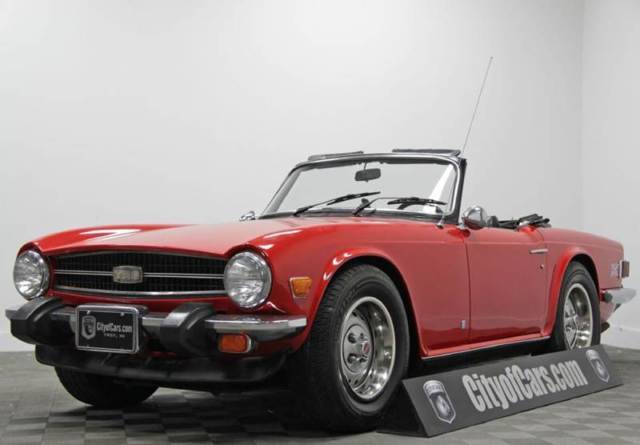1976 Triumph TR6 with Hard Top
- Price:
- Location: Troy, Michigan, United States
- Condition: Used
- Make: Triumph
- Model: TR-6
- Type: Convertible
- Year: 1976
- Mileage: 49,999
- VIN: CF57881U
- Color: Red
- Number of cylinders: 6
- Fuel: Gasoline
- Transmission: Manual
- Interior color: Black
- Options: Leather Seats
- Vehicle Title: Clear
1976 Triumph TR-6 Description
This Triumph TR6 would make a perfect driver or project car for a restoration. Car runs and drives well, and comes with color matched hardtop!
The Triumph TR6 (1968–76) is a British six-cylinder sports car and the best-seller of the TR range built by Triumph when production ended in July 1976. This record was then surpassed by the TR7. Of the 94,619 TR6s produced, 86,249 were exported; only 8,370 were sold in the UK.
The bodywork closely resembled that of the previous model, the Triumph TR5, but the front and back ends were squared off, reportedly based on a consultancy contract involving Karmann. This is referred to as a Kamm tail, which was very common during 1970s era of cars and a feature on most Triumphs. The body shape was similar to the TR4/TR5 except for the rear and front.
All TR6 sports cars featured inline six-cylinder engines. For the US market the engine was carburetted, as had been the US-only TR250 engine. Like the TR5, the TR6 was fuel-injected for other world markets including the United Kingdom, hence the TR6PI (petrol-injection) designation. The Lucas mechanical fuel injection system helped the home-market TR6 produce 150 bhp (110 kW) (145 hp DIN) at model introduction. Later, the non-US TR6 variant was detuned to 125 bhp (93 kW) for it to be easier to drive,[citation needed] while the US variant continued to be carburetted with a mere (but more reliable) 104 hp (78 kW).
The TR6 featured a four-speed manual transmission. An optional overdrive unit was a desirable feature because it gave drivers close gearing for aggressive driving with an electrically switched overdrive which could operate on second, third, and fourth gears on early models and third and fourth on later models because of constant gearbox failures in second at high revs. Both provided "long legs" for open motorways. TR6 also featured semi-trailing arm independent rear suspension, rack and pinion steering, 15-inch (380 mm) wheels and tires, pile carpet on floors and trunk/boot, bucket seats, and a full complement of instrumentation. Braking was accomplished by disc brakes at the front and drum brakes at the rear. A factory steel hardtop was optional, requiring two people to fit it. TR6 construction was fundamentally old-fashioned: the body was bolted onto a frame instead of the two being integrated into a unibody structure; the TR6 dashboard was wooden (plywood with veneer). Other factory options included a rear anti-roll bar and a limited-slip differential.
The UK version TR6PI could accelerate from zero to 60 mph (97 km/h) in 8.2 seconds and had a top speed of 120 mph (190 km/h) according to Autocar magazine.
As of Q1 2011, about 2723 licensed and 1320 SORN TR6s were registered with the DVLA in the UK.
Some say that the car is one of Leyland's best achievements, but a number of issues were present and remain because of poor design. These issues include a low level radiator top-up bottle and a poor hand-brake. As is the case with other cars of the era, the TR6 can suffer from rust issues, although surviving examples tend to be well-cared for. The TR6 can be prone to overheating. Many owners fit an aftermarket electric radiator fan to supplement or replace the original engine-driven fan. Also the Leyland factory option of an oil cooler existed. Parts and services to support ownership of a TR6 are readily available and a number of classic car owners' clubs cater for the model.
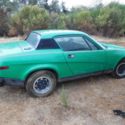 1976 Triumph TR7 Hard top
1976 Triumph TR7 Hard top
Mileage: 62783
 1976 Triumph TR6 Factory Hard Top and Air Condition!! In So Cal
1976 Triumph TR6 Factory Hard Top and Air Condition!! In So Cal
Mileage: 100063
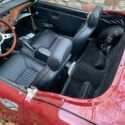 1976 Triumph Spitfire with hard and soft top
1976 Triumph Spitfire with hard and soft top
Mileage: na
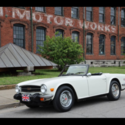 1976 Triumph TR6..Fully Restored..AC..One Repaint! Soft/Hard Top Included..
1976 Triumph TR6..Fully Restored..AC..One Repaint! Soft/Hard Top Included..
Mileage: 91989
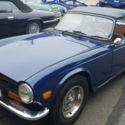 1974 Triumph TR6 Base Convertible 2-Door 2.5L with hard to find Hard Top
1974 Triumph TR6 Base Convertible 2-Door 2.5L with hard to find Hard Top
Mileage: 50,300
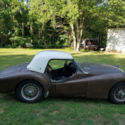 TR3 Triumph 1957 RARE Small Mouth + Two "Hard to Find" Hard Tops + 2 Back Seats!
TR3 Triumph 1957 RARE Small Mouth + Two "Hard to Find" Hard Tops + 2 Back Seats!
Mileage: 63,620
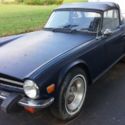 1976 Triumph TR-6 Convertible No Reserve Clear Title Made April, 1976 England
1976 Triumph TR-6 Convertible No Reserve Clear Title Made April, 1976 England
Mileage: 78,507
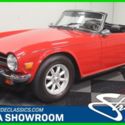 1976 Triumph TR-6 Convertible 1976 Used Manual
1976 Triumph TR-6 Convertible 1976 Used Manual
Mileage: 89879
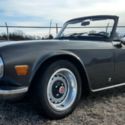 1969 TRIUMPH TR6 with Hard Top
1969 TRIUMPH TR6 with Hard Top
Mileage: 120000
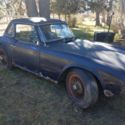 1969 Triumph TR6 with the hard top
1969 Triumph TR6 with the hard top
Mileage: 10,000,000
